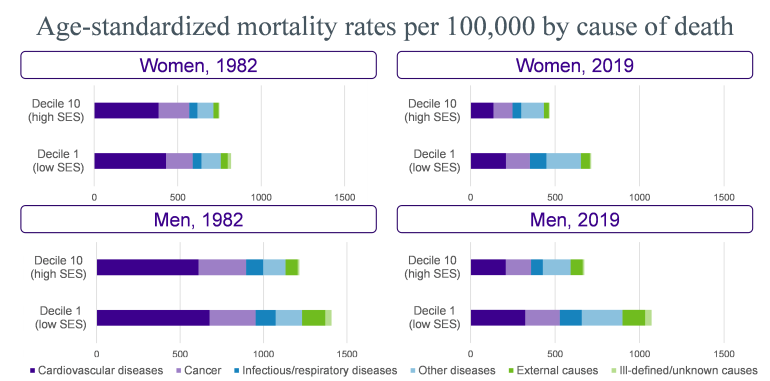Question:
Do causes of death affect socio-economic groups differently, and how has this changed over time?
Answer:
There certainly are some differences in the leading causes of death by socio-economic status (SES), and the contributions of different causes to mortality improvements over time has also varied by socio-economic group.
The charts below show all-cause mortality rates for men and women in 1982 and 2019 and for the top and bottom socio-economic decile of counties in the US, split by five broad groupings of cause of death. As expected, mortality rates are higher for lower socio-economic groups, are higher for men than women and have decreased over time (i.e, we have seen mortality improvements for all groups), but what else can we learn from these charts?

Key takeaways:
- The gap in mortality rates between high and low socio-economic groups has widened over time, i.e., improvements have been greater for higher socio-economic groups. Interestingly, this dynamic has resulted in high SES men now living longer than low SES women.
- Cardiovascular disease deaths dominate mortality rates for all groups (but to a lesser degree recently). Improvements over time have been largely driven by a reduction in cardiovascular disease death rates.
- “Other causes” saw increases for all groups over time – mostly driven by increases in diseases of the nervous system, such as Alzheimer’s disease. They now contribute more to overall mortality in high socio-economic groups than low socio-economic groups.
- Mortality rates for infectious and respiratory diseases increased for low socio-economic groups but decreased for high socio-economic groups. They contribute more to overall mortality for low socio-economic groups than high socio-economic groups.
- Cancer mortality rates have declined for all groups over time, at roughly the same rate. They contribute more to overall mortality for high socio-economic groups than low socio-economic groups.
The key questions are:
- How might mortality rates for these different groups change in the future?
- Have we exhausted the achievable advances in reducing cardiovascular deaths, or are there more significant gains coming?
- What could be the next driver of significant mortality improvements? And will it be experienced differently by men and women or by socio-economic status?





